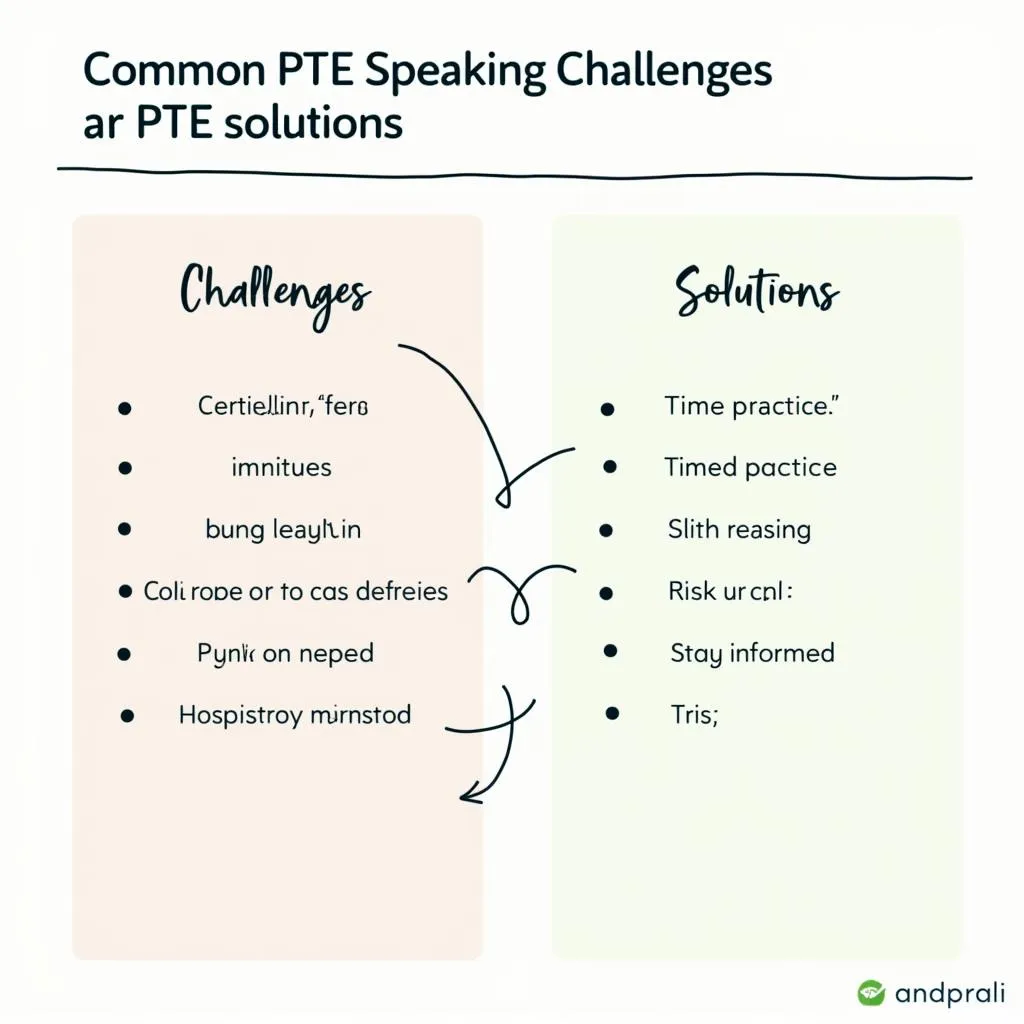Mastering fluent speaking for the PTE Academic exam is crucial for achieving a high score. This comprehensive guide will provide you with effective strategies and practical tips to enhance your speaking skills and boost your confidence in the PTE speaking section.
Understanding the PTE Speaking Section
Before diving into practice techniques, it’s essential to grasp the structure of the PTE speaking tasks. The speaking section consists of various question types, including:
- Read Aloud
- Repeat Sentence
- Describe Image
- Re-tell Lecture
- Answer Short Question
Each task assesses different aspects of your speaking abilities, from pronunciation and fluency to content and oral fluency.
 PTE Speaking Section Overview
PTE Speaking Section Overview
Key Strategies for Improving Speaking Fluency
1. Daily Practice Routine
Consistency is key when it comes to improving your speaking fluency. Establish a daily practice routine that includes:
- Reading aloud for 15-20 minutes
- Recording yourself speaking on various topics
- Shadowing native English speakers
- Participating in language exchange programs
Dr. Emma Thompson, a renowned PTE expert, emphasizes, “Regular practice is the cornerstone of fluency improvement. Even 30 minutes a day can make a significant difference in your speaking abilities.”
2. Expand Your Vocabulary
A rich vocabulary is essential for expressing yourself fluently. To broaden your word bank:
- Learn new words in context
- Use vocabulary apps like Quizlet or Anki
- Read diverse English materials (newspapers, novels, academic journals)
- Practice using new words in sentences
 Vocabulary Expansion Techniques for PTE Speaking
Vocabulary Expansion Techniques for PTE Speaking
3. Improve Pronunciation and Intonation
Clear pronunciation and natural intonation are crucial for fluent speaking. Try these techniques:
- Use pronunciation apps like ELSA Speak or Google’s Speech-to-Text
- Practice tongue twisters
- Record yourself and compare with native speakers
- Focus on stress and intonation patterns in English
4. Utilize PTE-Specific Resources
Take advantage of resources tailored for PTE preparation:
- Official PTE practice materials
- Online PTE forums and communities
- PTE preparation courses
- Mock tests and sample questions
Professor James Carter, a PTE speaking coach, advises, “Familiarizing yourself with the PTE format through dedicated resources can significantly boost your confidence and fluency during the actual test.”
Practical Tips for Each PTE Speaking Task
Read Aloud
- Practice proper pacing and breathing
- Focus on clear articulation of words
- Pay attention to punctuation marks for natural pauses
Repeat Sentence
- Develop active listening skills
- Focus on capturing the overall meaning
- Practice with gradually increasing sentence lengths
 Repeat Sentence Practice Technique
Repeat Sentence Practice Technique
Describe Image
- Develop a structure for your response (introduction, key features, conclusion)
- Practice describing various types of images (graphs, maps, processes)
- Use a range of descriptive vocabulary and transition words
Re-tell Lecture
- Improve note-taking skills
- Focus on key points and main ideas
- Practice summarizing information concisely
Answer Short Question
- Work on quick thinking and response time
- Build a wide range of general knowledge
- Practice giving concise, direct answers
Overcoming Common Challenges
Many PTE test-takers face challenges such as nervousness, time pressure, and lack of ideas. Here are some strategies to overcome these obstacles:
- Manage anxiety through deep breathing and positive self-talk
- Improve time management with regular timed practice sessions
- Stay informed about current events to have a reservoir of ideas
- Practice speaking on unfamiliar topics to boost adaptability
Dr. Sarah Lee, a cognitive linguist specializing in language testing, notes, “The key to overcoming speaking challenges lies in building confidence through targeted practice and developing effective coping strategies.”
 Overcoming PTE Speaking Challenges
Overcoming PTE Speaking Challenges
Integrating Technology in Your Practice
Leverage technology to enhance your speaking practice:
- Use speech recognition software for pronunciation feedback
- Join online speaking clubs or language exchange platforms
- Utilize AI-powered language learning apps
- Record and analyze your speaking samples using audio editing tools
Conclusion
Improving your speaking fluency for the PTE exam requires dedication, consistent practice, and the right strategies. By following the tips and techniques outlined in this guide, you can significantly enhance your speaking skills and approach the PTE speaking section with confidence. Remember, the key to success lies in regular practice and a willingness to step out of your comfort zone. Start implementing these strategies today, and watch your fluency soar!
FAQs
-
How long should I practice speaking each day for PTE?
Aim for at least 30-60 minutes of focused speaking practice daily for optimal improvement. -
Can watching English movies help improve my PTE speaking skills?
Yes, watching English movies can help improve your listening skills, pronunciation, and vocabulary, all of which contribute to better speaking fluency. -
What’s the best way to practice for the Describe Image task?
Regularly describe various types of images (charts, graphs, maps) within the given time limit, focusing on structure and relevant vocabulary. -
How can I improve my response time for the Answer Short Question task?
Practice quick-fire question-and-answer sessions on diverse topics and work on enhancing your general knowledge. -
Is it beneficial to speak with a native-like accent for the PTE exam?
While a native-like accent isn’t necessary, clear pronunciation and natural intonation are important for scoring well in the speaking section. -
How can I make my PTE speaking practice more effective?
Record yourself, analyze your speeches, seek feedback from others, and focus on improving specific areas like fluency, pronunciation, and content. -
What role does grammar play in the PTE speaking tasks?
While grammar is not explicitly scored in speaking tasks, using correct grammar contributes to overall coherence and fluency, which are assessed.